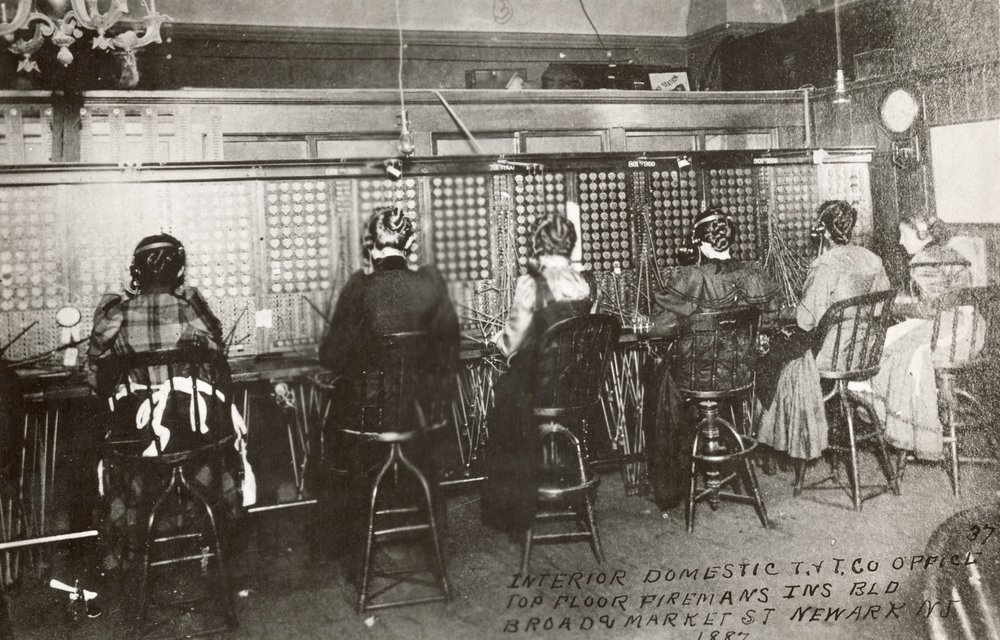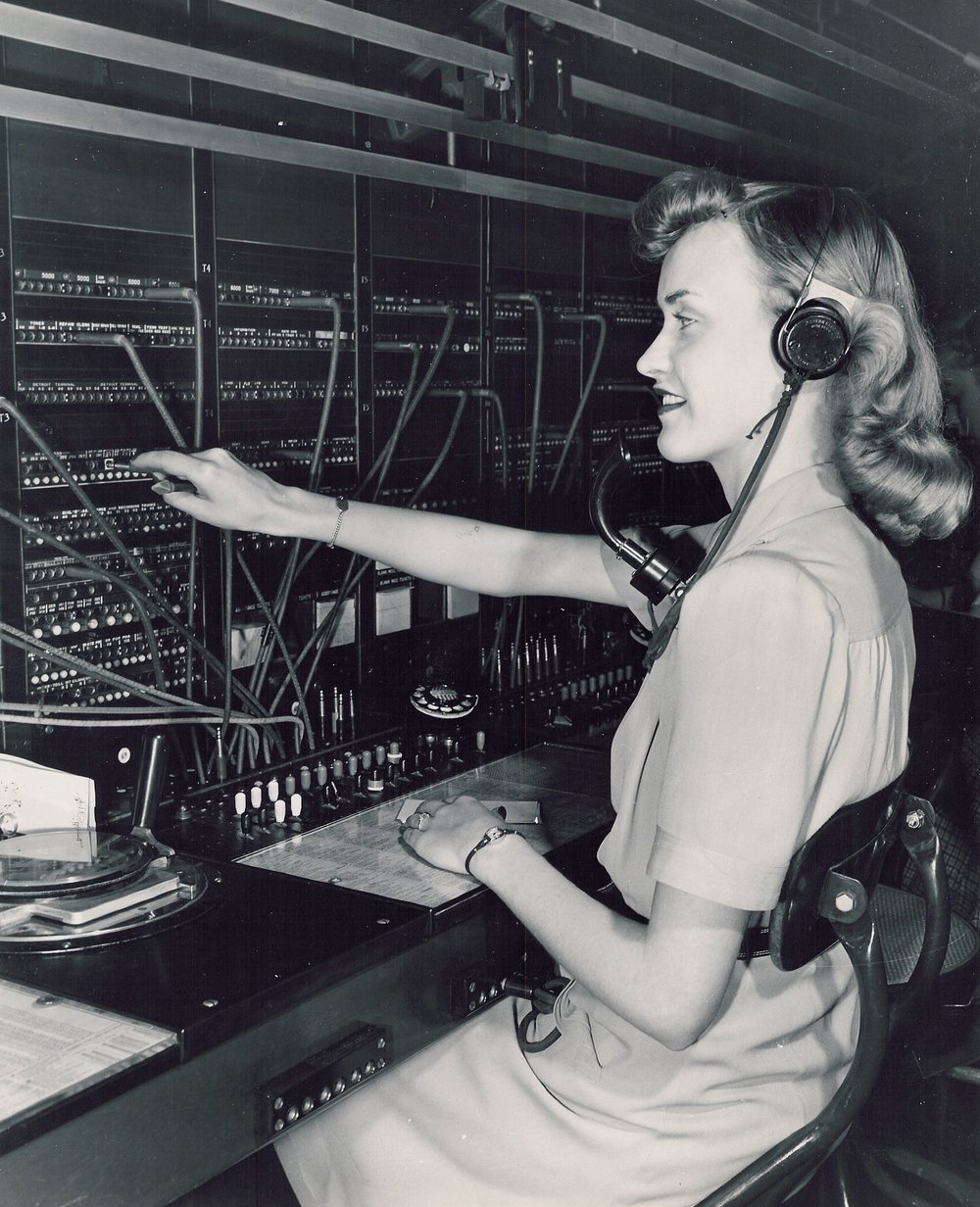
The Operator
More information on “THE OPERATOR: "THE VOICE WITH A SMILE"“
Click here to return to Gallery 1.
Quote from Carol Zinn

“I found it interesting work to realize how people were connected by phone and I was responsible for making the connection.”
Carol Zinn, Recalling her time as an operator in 1960s Newark.
Switchboard, Patented December 28, 1897

This switchboard is typical of what would have been used in rural areas. Early New Jersey phone users would have had their call routed through a switchboard like this one. In addition to connecting callers, operators also provided information services and helped customers answer questions beyond telephone call-related inquiries including the time and weather. One operator recalled a young boy calling to ask what time his school bus came.
Collection of AT&T Archives and History Center.
PBX Switchboard, Model 556, 1950s

Possibly made in Kearny, NJ.
The PBX (Private Branch Exchange) switchboard , possibly made in Kearny, NJ was used to connect internal calls within a business, as well as linking them into the greater Bell system. The addition of a PBX to a company would also mean hiring dedicated operators. View the inner workings of the switchboard around the back.
Collection of AT&T Archives and History Center.
Sign for American Telephone & Telegraph, c.1939-64

Collection of AT&T Archives and History Center.
Newark Telephone Exchange Directory, 1879

This 1879 directory for the city of Newark takes up just one sheet of paper. Considering the first phone call was only made three years earlier, however, the growth of the Bell System is remarkable. Note the absence of phone numbers.
Image Courtesy of AT&T Archives and History Center.
Exterior of the Bell Telephone Building on Washington Park, 1941

Newark was home to the New Jersey Bell Headquarters.
In 1929, they opened a twenty-two story Art Deco building on Washington Park. The building boasted 500 offices, a 300-seat auditorium, recreation rooms, a restaurant, cafeteria, and a medical department. In addition to marble mosaics and a gilded lobby, the façade includes six sculptures by Edward McCartarn (1879–1947) that depict telephone company employees and customers. Today the building is known as Walker House; a few floors hold telephone switching equipment (a few floors hold telephone switching equipment for Verizon), while the rest serves as an apartment building.
Image Courtesy of The Newark Public Library.
Traffic Operators in Newark, NJ, 1887

Newark was a central hub through which local exchanges were routed. Voice operated telephone connections required finesse, a job fit for socially adept young women. Phone companies almost exclusively hired single white women for their telephone operator positions. The first operators were teenage boys, who had worked in the telegraph business. It was assumed they would easily make the transition to connecting calls and could also be used to repair lines but in many cases the boys proved too rowdy, even playing pranks on customers.
Image Courtesy of AT&T Archives and History Center.
Switchboard Operators and Supervisors, Rockaway, NJ, 1930s

By the 1930s, operator jobs were still exclusively marketed to women. The Bell System was the largest private employer of women. By 1938, there were 115,000 female operators in the Bell System and it was projected that 25,000 more were needed to fill demand. An important quality for an operator was the ability to enunciate. This meant that people without accented speech were preferred and discrimination against immigrants and minorities occurred frequently.
Image Courtesy of AT&T Archives and History Center.
Operator, 1953

By 1950, the Bell System employed over 340,000 operators – this equates to one in thirteen working women. An additional one million women operators were employed by private businesses. By 1984, this number was down to around 40,000 total switchboard operators in the US including private business exchange employees.
Image Courtesy of AT&T Archives and History Center.
First Traffic Service Position System installed in Morristown, NJ. Replaced older switchboards (can be seen far right)

The Traffic Service Position System (TSPS) was a shift away from the traditional switchboard. Connections were completely automated unless a customer required special assistance. TSPS greatly increased the speed of calls, making the work of operators impossibly fast-paced. Operators were expected to answer every incoming call within three seconds, announced with a beep directly in their headphones. The grueling pace and working conditions led to job dissatisfaction and health complaints.
Image Courtesy of AT&T Archives and History Center.
The First TSPS Operators in the United States, Morristown, NJ, 1969

The 1960s saw an increase in the hiring of black women as operators. The wages of operators were in decline and white women found they could earn more elsewhere. However, for black women who were regularly barred from many workplaces, the job of operator was a new opportunity. In a paper delivered at the 1969 Bell System’s Presidents’ Conference, AT&T Vice President Walter Straley explained, “...we need nonwhite employees. Not because we are good citizens. Or because it is the law as well as a national goal to give them employment. We need them because we have so many jobs to fill and they will take them.”
Image Courtesy of AT&T Archives and History Center.











